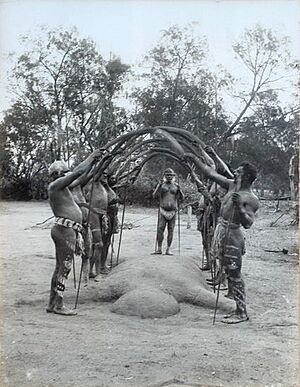Bora (Australian) facts for kids
The Bora is a special initiation ceremony for Aboriginal boys in Eastern Australia. This ceremony helps boys become men in their community. The word "bora" also refers to the specific place where these ceremonies happen.
During a Bora ceremony, boys who have reached puberty learn important traditions. They are taught sacred songs, special dances, and the history and beliefs of their tribe. Many different groups of Aboriginal people would come together for these ceremonies. Women and younger children were not allowed to be at the sacred Bora ground where these important rituals took place. The ceremonies involved special traditions that marked their new status.
What is Bora?
Bora ceremonies are a type of rite of passage. This means they are an important event that marks a big change in a person's life. For Aboriginal boys, the Bora ceremony marked their journey from childhood to becoming a man. It was a time for them to learn the deep spiritual knowledge and responsibilities of their community.
Where Does the Name Come From?
The word Bora first came from the Gamilaraay language. This language was spoken by the Kamilaroi people. They lived in an area stretching from northern New South Wales to southern Queensland. Over time, the word "Bora" became widely used. It now describes similar special sites and ceremonies across Eastern Australia.
Other Aboriginal groups have their own names for these ceremonies. For example, the Wiradjuri people call it burbung. The Yuin people use the word kuringal. The word "Bora" itself is thought to come from the special belt worn by initiated men.
Bora Sites and Their Meaning
The places where Bora ceremonies happen, called Bora grounds, look different in various cultures. Often, these sites have stone arrangements or rock carvings. These artworks are part of the sacred space.
In southeastern Australia, Bora sites often have two circles drawn on the ground. These circles are connected by a path. This design is thought to represent a "sky Bora" or patterns seen in the Milky Way.
Typically, a Bora ground has a larger circle, about 20 to 30 meters wide. There is also a smaller circle, around 10 to 15 meters wide. The larger circle was a more public space. The smaller circle was sacred and only for initiated men and the boys being initiated.
In southeast Australia, the Bora is often linked to the creator-spirit Baiame. In the Sydney area, large earth mounds were sometimes made. These mounds were shaped like long bands or simple circles. Sometimes, boys would walk along a path marked on the ground. This path showed their journey from childhood to manhood. The path might have stone arrangements or special "spirit footprints" carved into the rock.
Other Bora sites in southeast Australia might have two stone circles. The boys would start the ceremony in the larger, public circle. They would finish in the smaller, more sacred circle. Only initiated men were allowed into the smaller circle.
One good example of a two-ring Bora site was in Alberton, Queensland. Sadly, it was destroyed in the late 1950s to make way for a pineapple farm. The smaller southern ring at this site had a structure like a dolmen.
The two rings at Bora sites are joined by a sacred walkway. Most of these sites are found in southeast Queensland and eastern New South Wales. Five earth rings have also been found near Sunbury in Victoria. However, it is not known if Aboriginal people used these specific rings for ceremonies.
Bora rings made of individually placed stones can be seen in Werrikimbe National Park in northern New South Wales.


